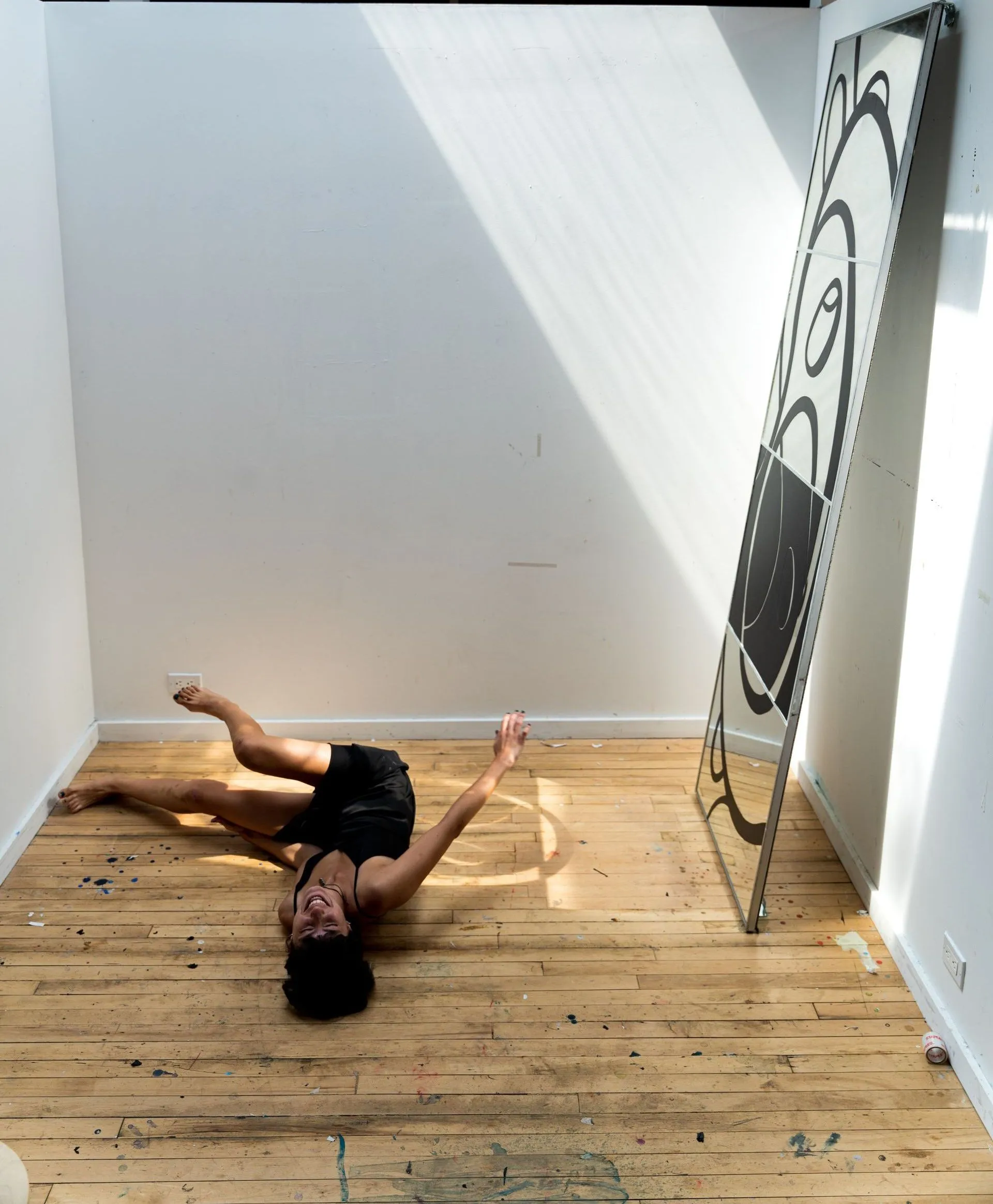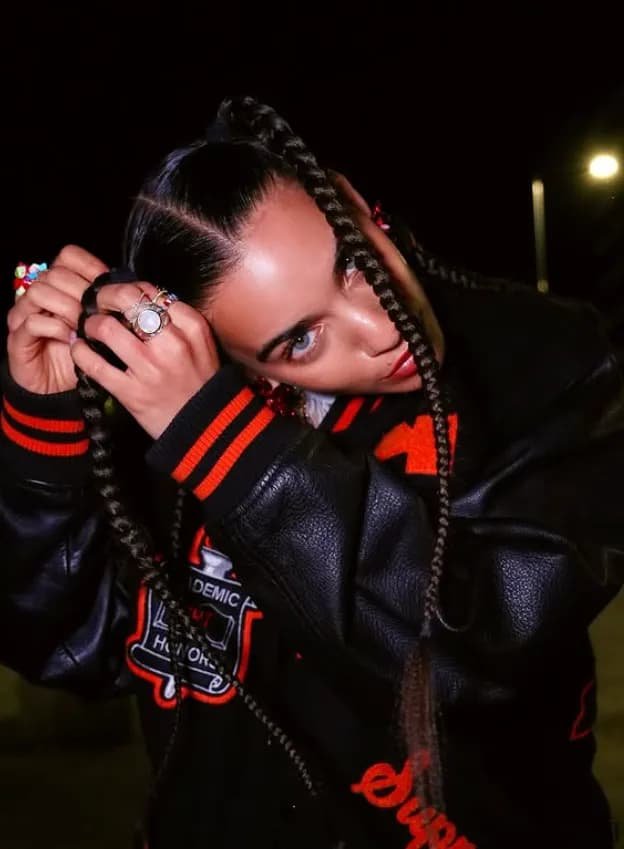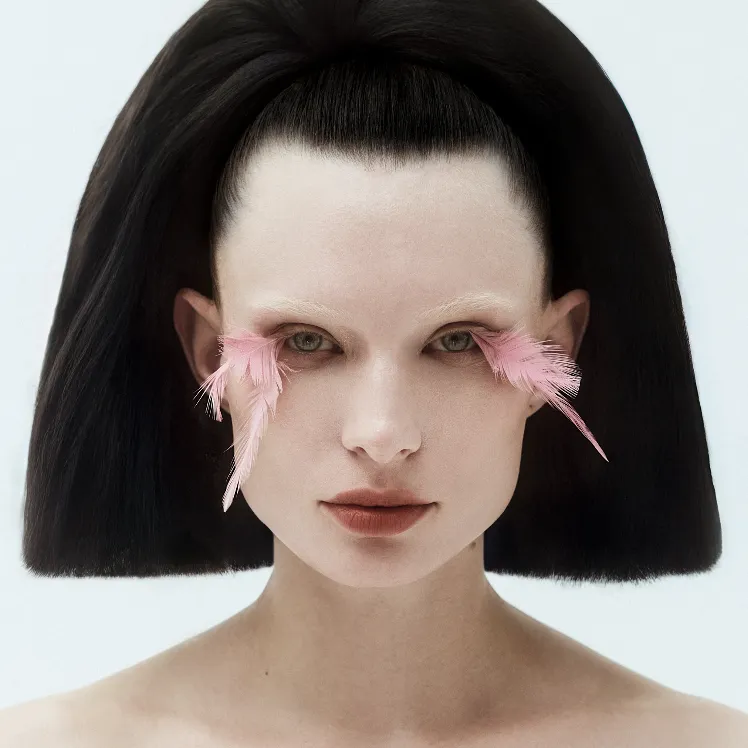What’s the first thing that appears when you begin a work: an image, an emotion, or an energy?
I think the starting point varies depending on the piece. Sometimes the image comes first, almost like a sudden vision, and it usually carries a very clear emotion, as if that feeling needs to take shape. Other times, the trigger is a more subtle sensation: the energy I perceive in a space, a situation, or even a fleeting moment. It’s as if something vibrates in the air and pushes me to translate it visually. In both cases, what guides the process is a deep connection with the intangible, with that force you feel before you can name it.
Your figures seem suspended in an in-between space. What role does emptiness play in your work?
For me, emptiness is an active space, not an absence. In my work, emptiness isn’t just the background or what surrounds the figures — it’s a presence in itself, a vibrational field where anything can emerge.
I work a lot with the idea of the “in-between,” that intermediate space where forms are not fully defined but are already loaded with intention. I’m drawn to that moment before a final form, where there’s still mystery, possibility, openness. It’s a fertile space where the invisible begins to take shape.
That “emptiness” also resonates deeply with Eastern philosophies, where emptiness isn’t a void, but a container of potential energy. I like to think of my figures as floating or suspended there — not because they’re lost, but because they’re in transition, connected to something more subtle.
What did you discover about yourself in moving from design and ceramics to oil painting?
I discovered that everything we do eventually becomes a tool for what comes next. Having worked in design and ceramics gave me a strong foundation — not just technically, but in terms of visual thinking and sensitivity. Switching to oil painting felt like opening a new door, but carrying a suitcase full of past experiences that allowed me to move more freely. I realized that being multidisciplinary doesn’t just make you more versatile; it also trains you to solve problems, adapt, and flow through the challenges of the creative process. Everything leaves a mark, and in some way, everything connects.
What role does the spiritual — not as dogma, but as vibration — play in your work?
Since I began exploring energy — especially the concept of “Qi” in Chinese tradition — my artistic practice has become a channel to tune into those subtle forces, not as dogma, but as vibrations that run through all things.
To me, spirituality isn’t a series of abstract ideas: it’s a physical, almost sensory experience. When I’m in the studio, I close my eyes and hold a piece of clay — I’m not thinking of preconceived shapes. I let the feeling of energy manifest through my hands, and from there, a figure emerges — one that later repeats and comes to life in my work.
Do you want your works to be understood or felt?
Honestly, I care about both. I’m deeply moved when someone stands in front of a piece and, without needing any explanation, connects with its meaning through observation and emotion. It’s a very special moment when someone approaches and asks if what they felt is what I wanted to express — because that’s when I know the work spoke for itself. Ideally, I want the piece to be felt first and then, if desired, understood. Art has that unique ability to bypass the rational and touch something deeper.
What’s it like to begin monetizing your work as an emerging artist? Is that an important part of thinking about art?
Starting to monetize your work isn’t easy, and in my opinion, it depends a lot on where you’re based and how the local market works. For me, the first and maybe most important step was treating being an artist as seriously as any other job. That means applying discipline and devoting a set number of hours per day not just to making art, but to all the other tasks that are part of developing an artistic career.
We often want to just be creating in the studio — at least I do — but there are other things to do that play a key role in monetization, and they’re not always the most enjoyable tasks for an artist.
What have you learned from showing your work in such different places as Buenos Aires, New York, and London?
I’m very grateful to have had the chance to show my work in such diverse cities. Each place has its own energy, its own way of looking — and that has enriched me immensely. Seeing how people from different cultures relate to my work, how they interpret it through their own references and sensitivities, really opened my eyes. It helped me understand that the artwork lives on beyond me. It’s a constant exchange: I bring something of myself to those places, and at the same time, each place transforms me.
What has been your biggest challenge as a young artist in a city like New York?
I think the biggest challenge has been balancing the city’s fast pace with my work and staying focused on my personal goals. New York is full of events — especially art-related ones — throughout the year. There’s so much activity, inspiration, and opportunity, but all of that can also be distracting. At the same time, that’s what makes the city so valuable — you’re constantly bumping into inspiration, people, or conversations that fuel your creativity. It’s a double-edged sword, and you have to know how to handle it so you don’t get lost in the noise.
When have you felt fear in your creative journey, and how did you overcome it?
I felt a lot of fear when I moved to New York. The city seemed huge, overwhelming, and I was in a moment of deep uncertainty: I wasn’t even sure if I really wanted to continue down the path of art, which I had only just begun a year before arriving. But luckily, the path began to reveal itself little by little. The signs started to show up, small doors began to open, and with each step I understood that I was going in the right direction. For me, the key was to surrender fully to the work — with effort, consistency, and commitment — until things slowly began to align with my purpose.
Was it hard for you to recognize yourself as an artist? Was there a turning point when you said: “this is what I’m meant to do”?
At first it was hard, especially because I wasn’t even sure I could call myself an “artist.” That doubt came from personal insecurity, fueled by the elitism that often surrounds the art world. For a long time, I felt that the title didn’t belong to me. But over time, I understood something fundamental: we’re all artists in potential, and what truly defines the role is dedication, discipline, and commitment to what we do.
I always knew I wanted to work in something art-related, but when I studied graphic design, I felt something was missing — like I hadn’t quite found my place. The day I painted with oil for the first time, I felt it with total clarity: this is it. That’s when everything started to make sense.
What would you say to your 20-year-old self, who was just beginning to paint without knowing what was ahead?
Well, I started painting at 24, so I’d tell my 20-year-old self to start as soon as possible. To dare to play, to experiment, to enjoy without fear. I’d tell her to read a lot about art history, to get lost in museums, to go to every exhibition she can. To immerse herself in painting like diving into a freezing pool on the hottest day of the year: fully, without overthinking, with passion and excitement. Because art doesn’t wait — but it always rewards those who leap.








